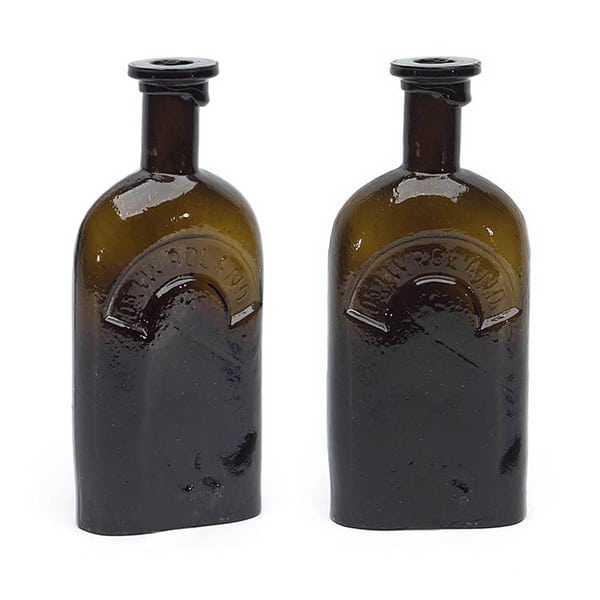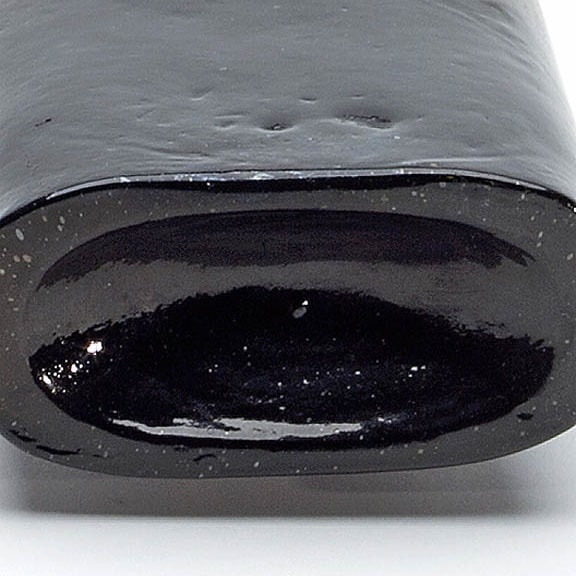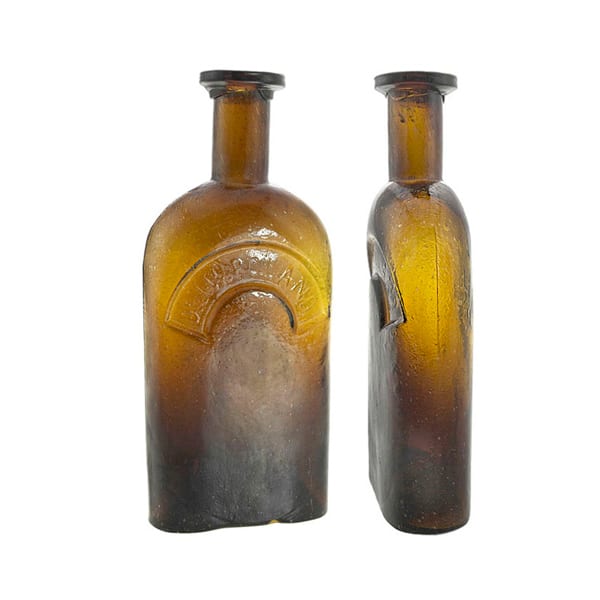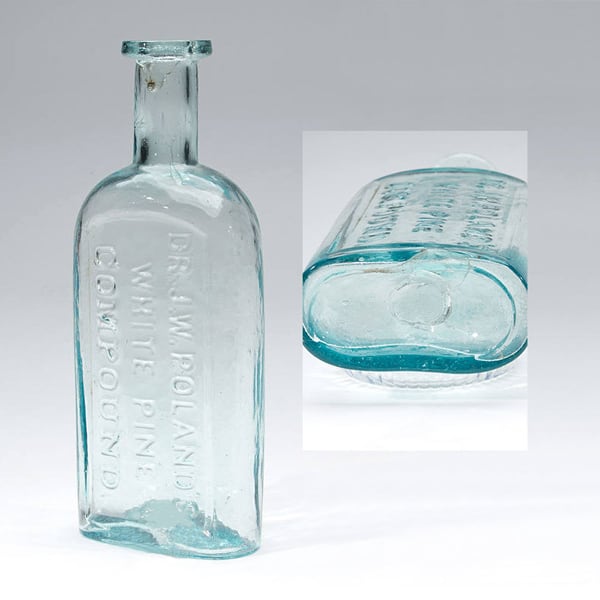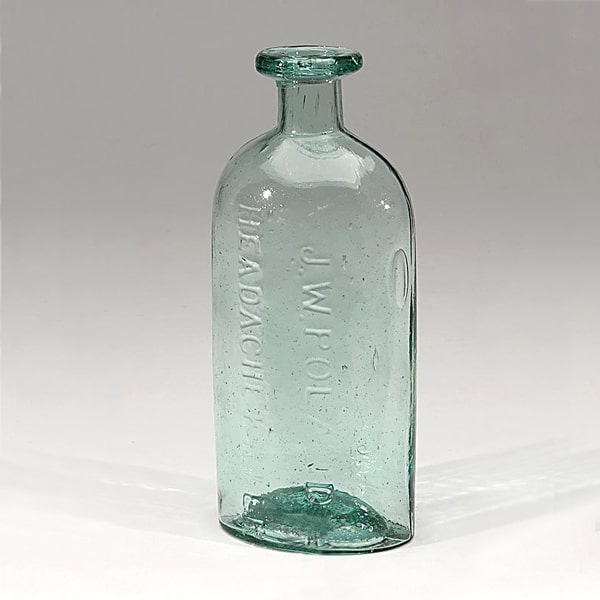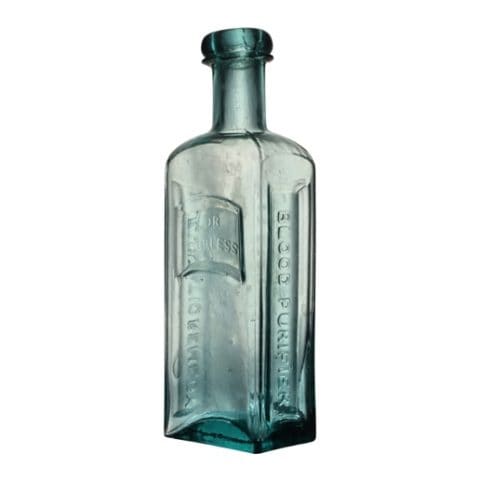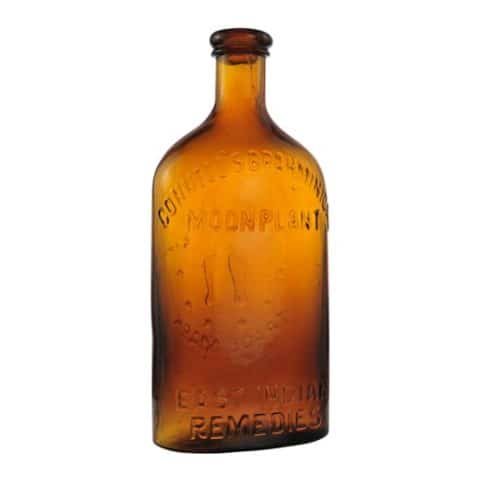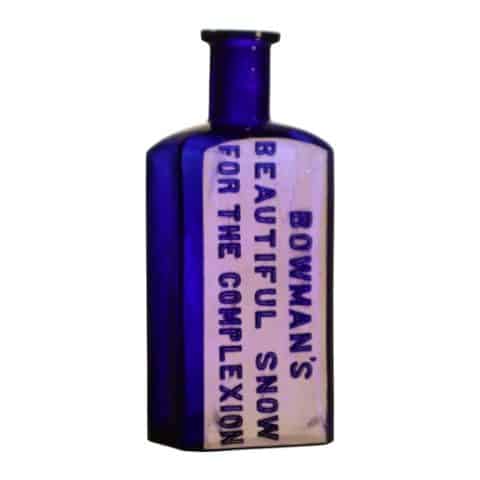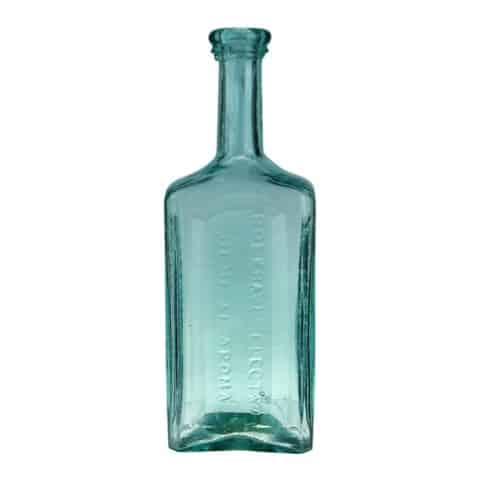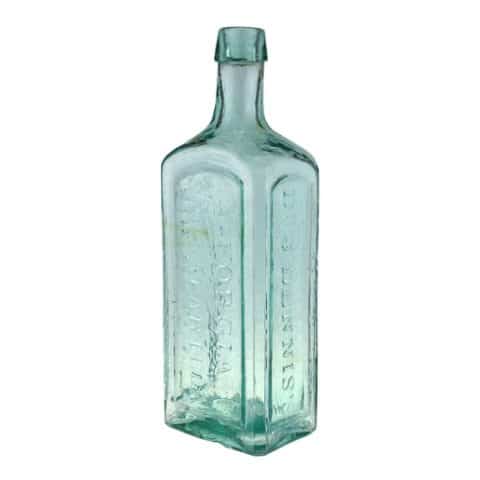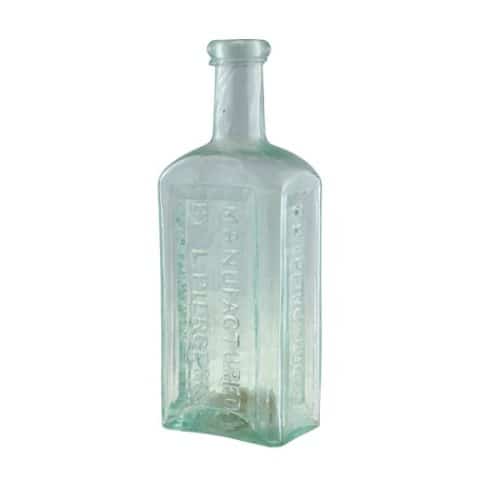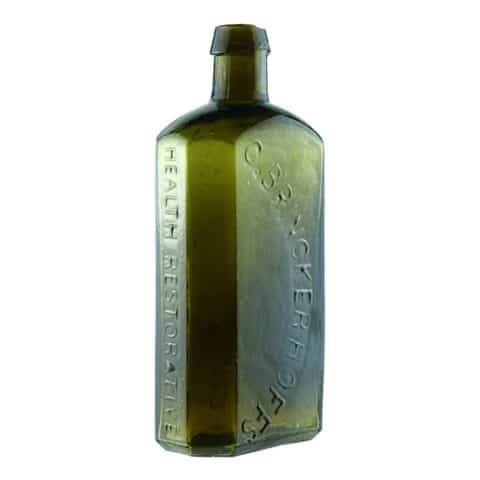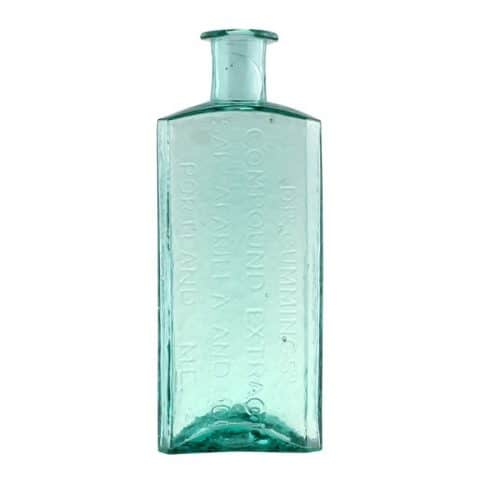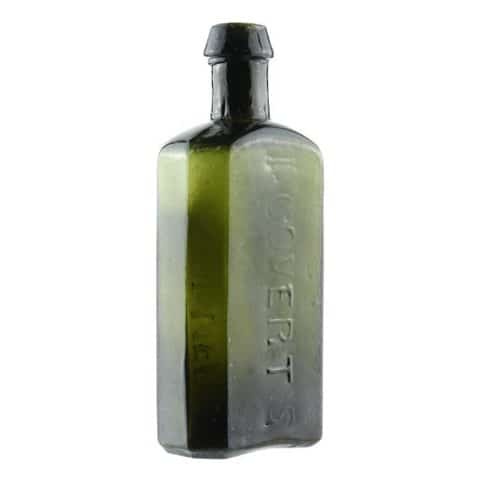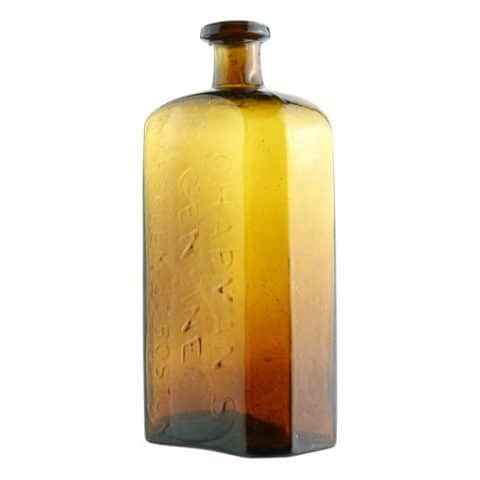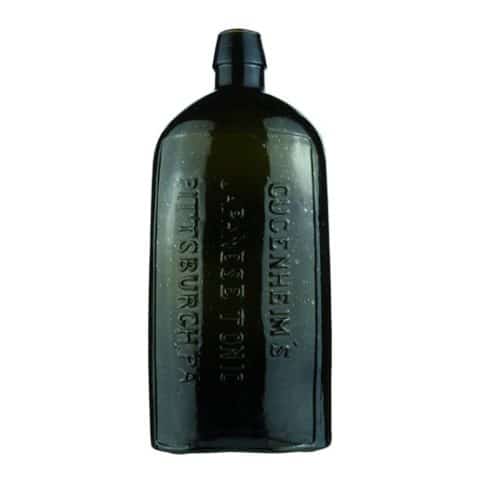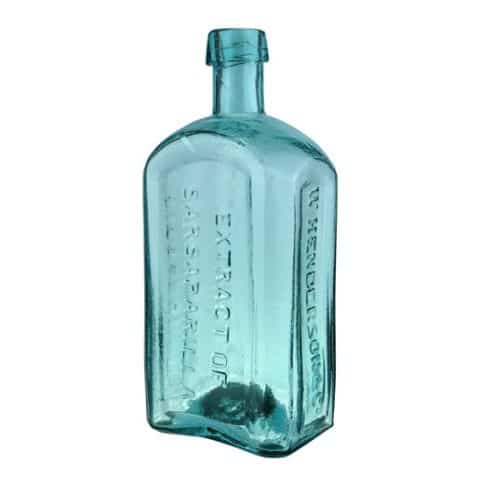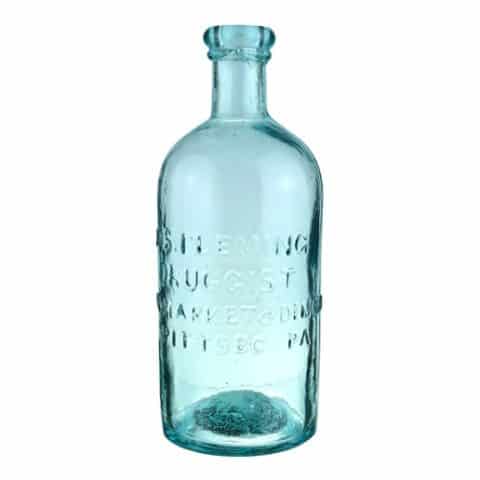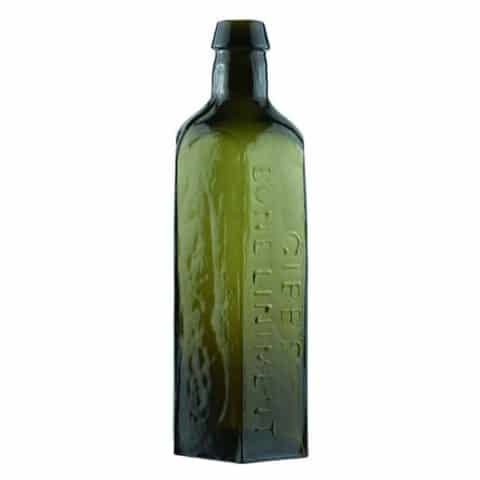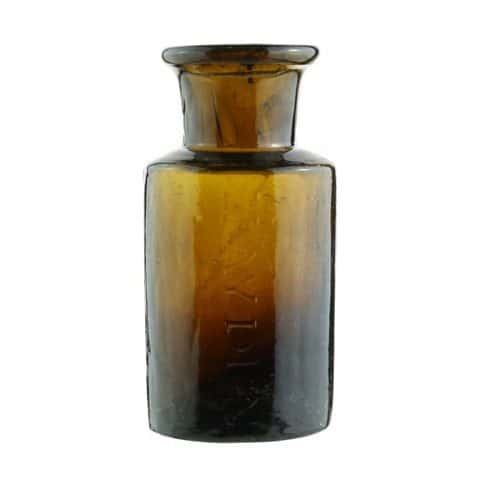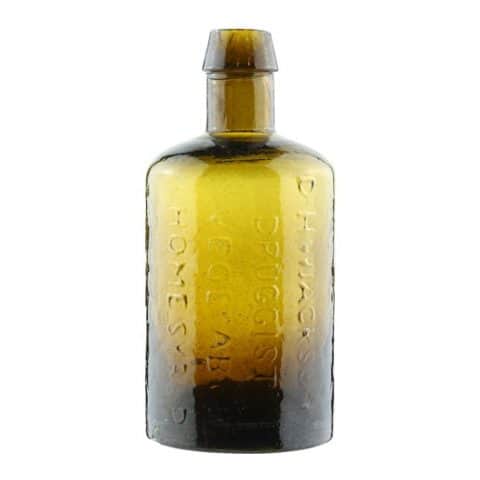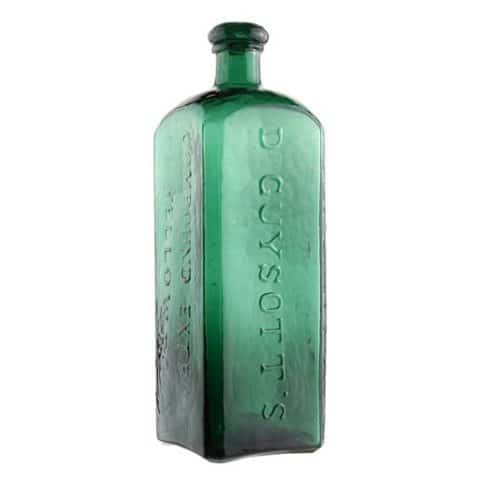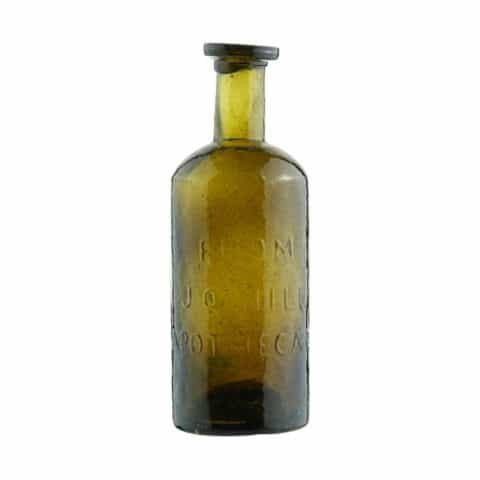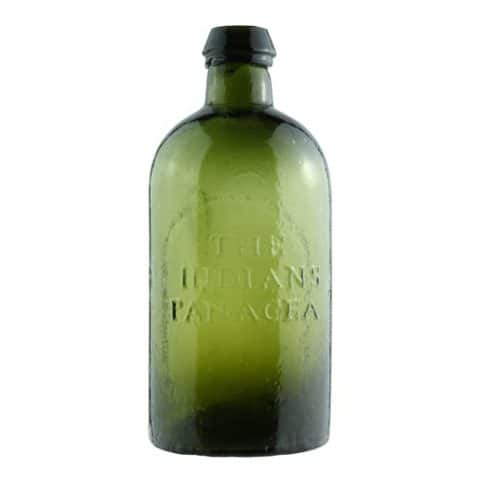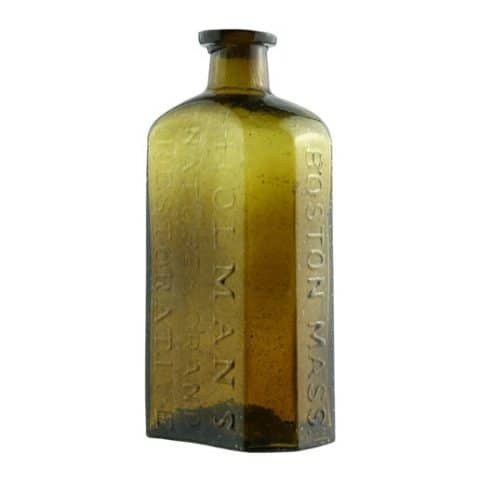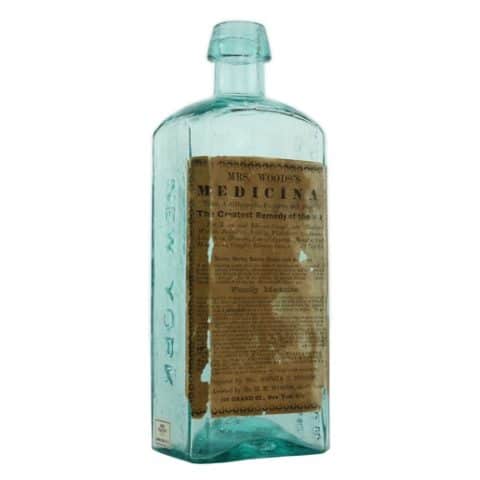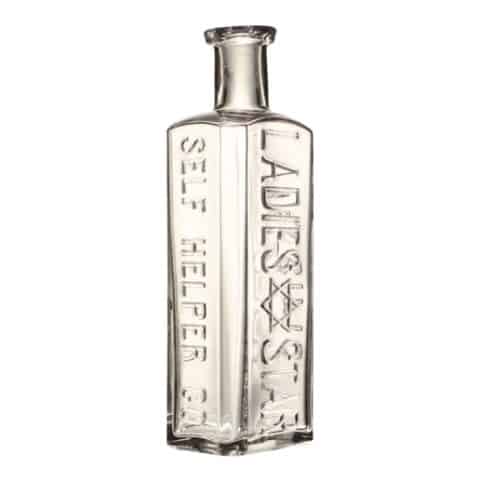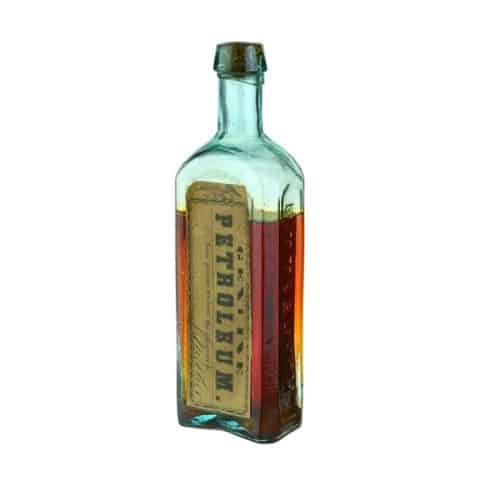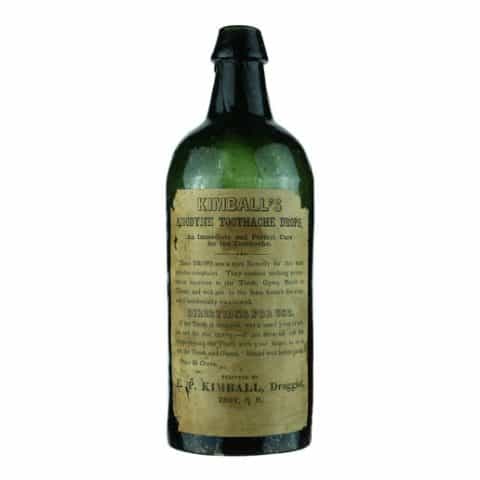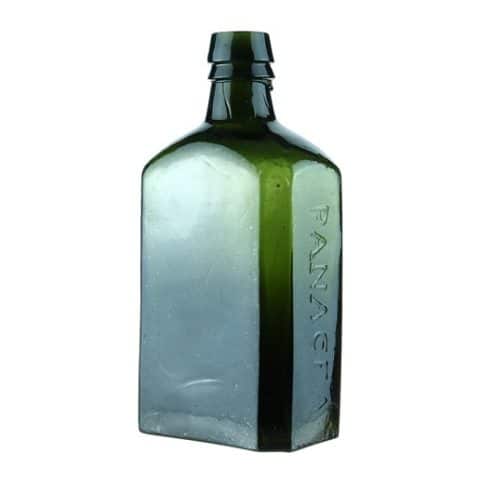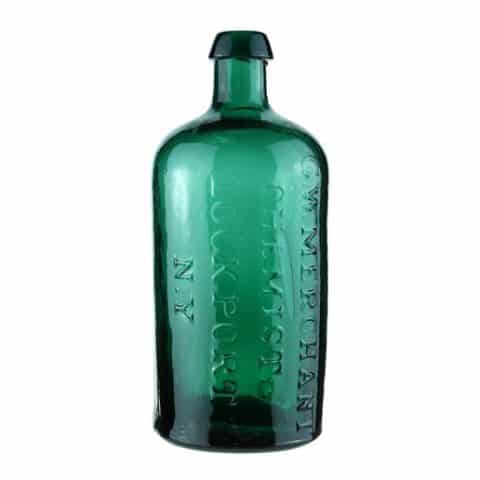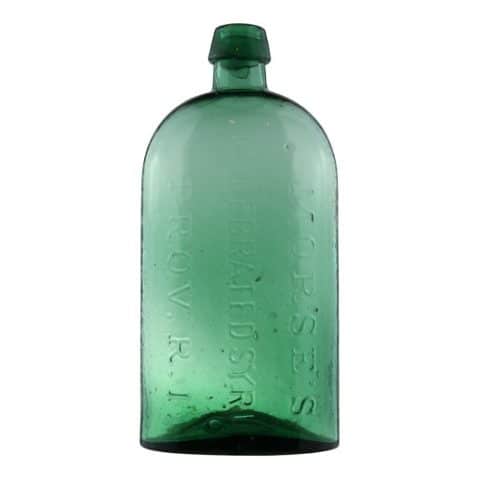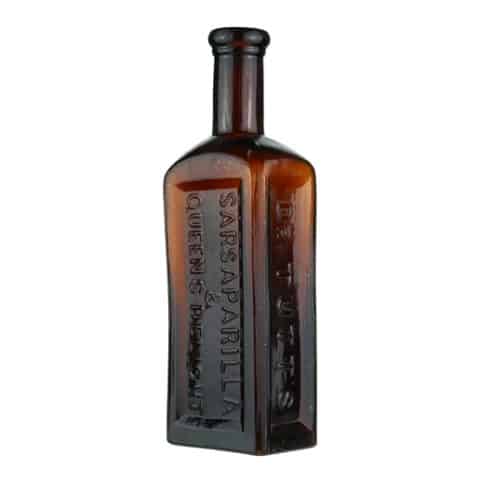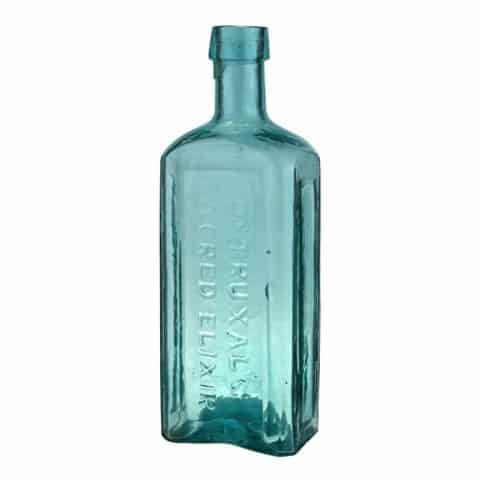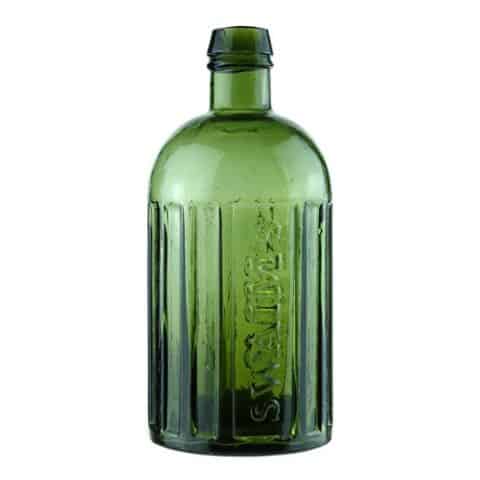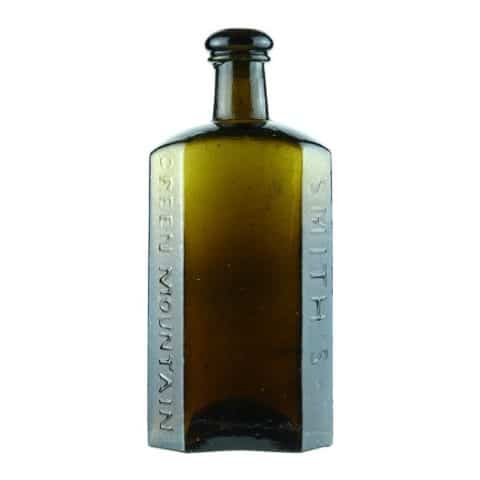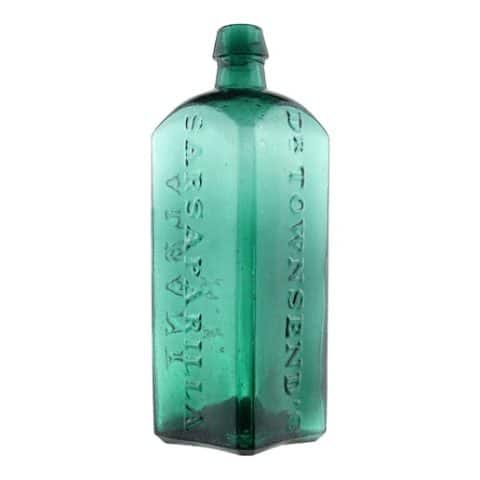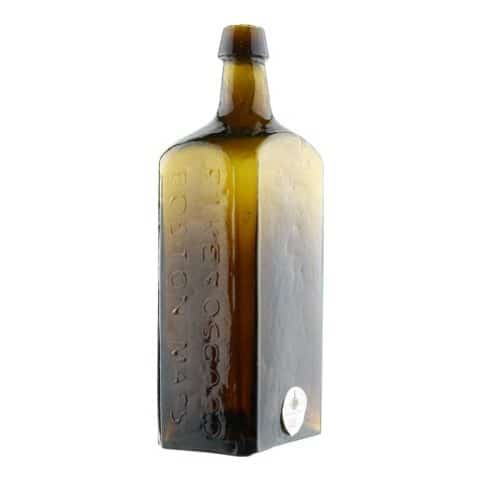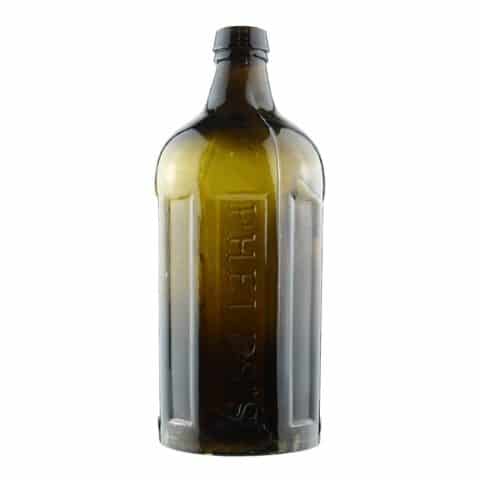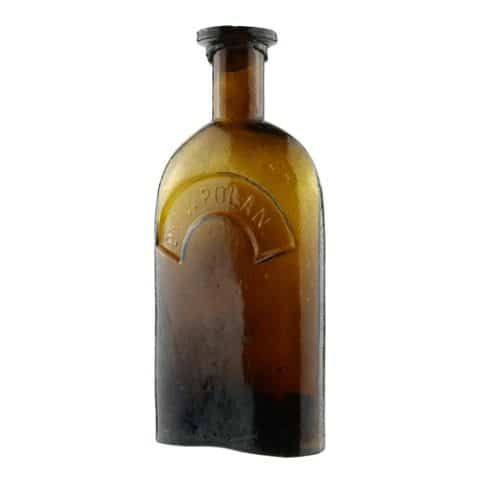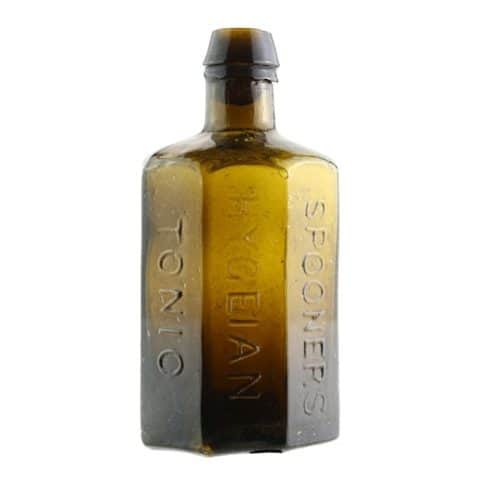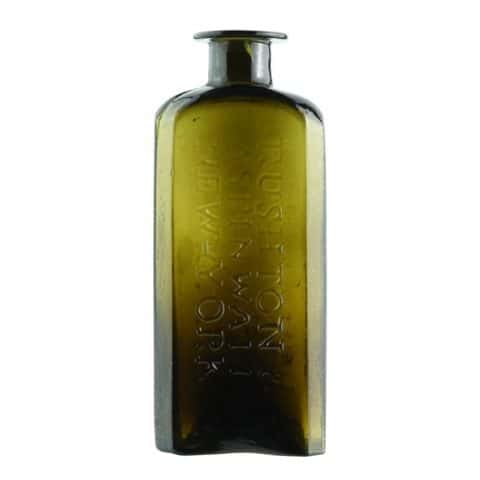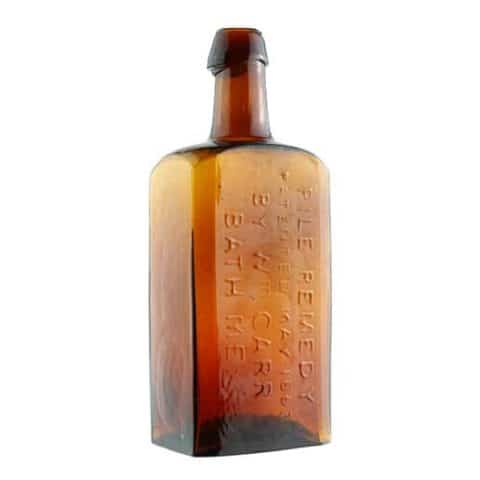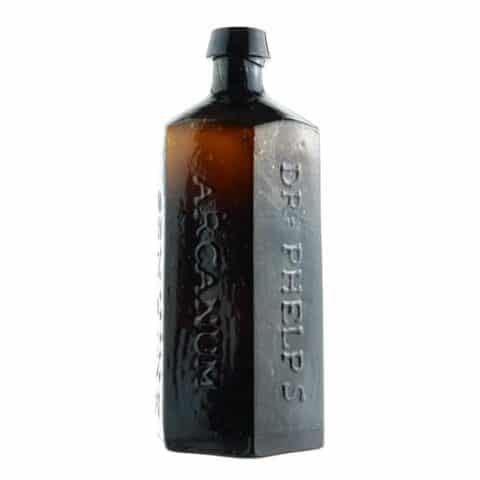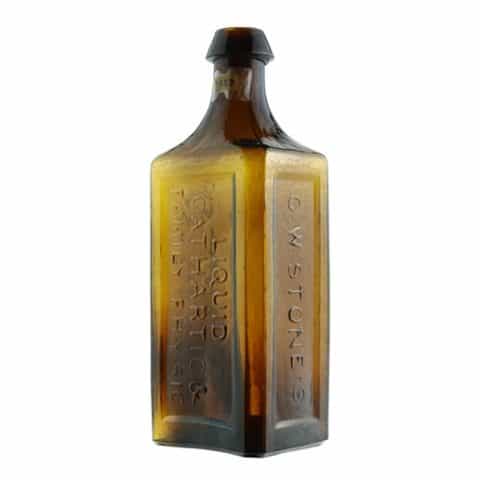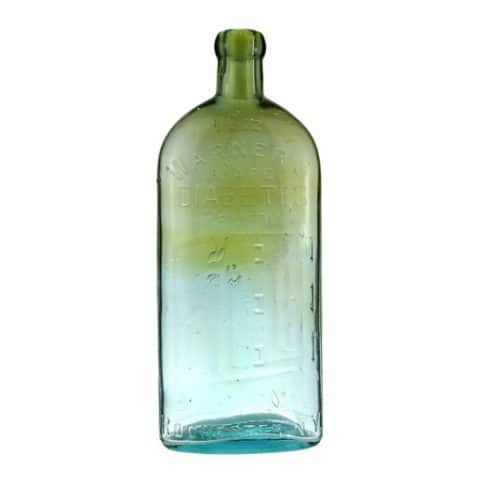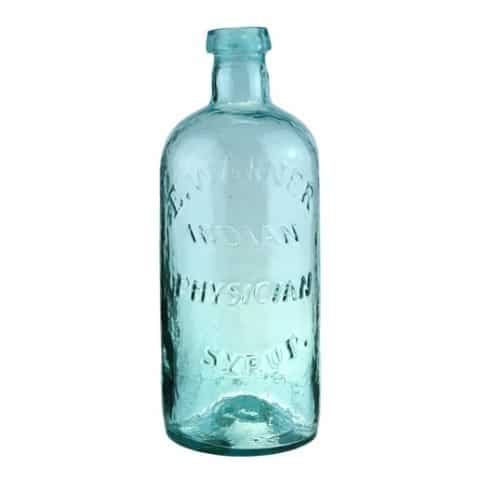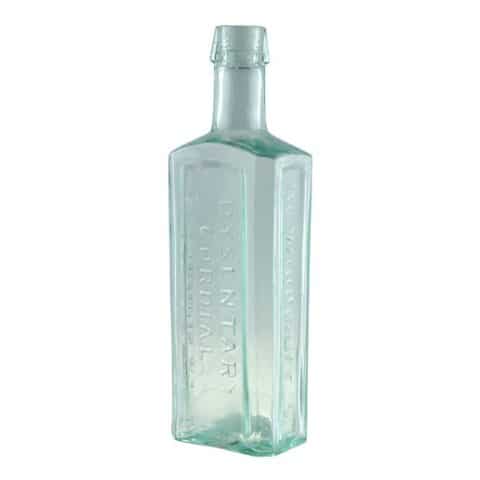Dr. J. W. Poland
Dr. J. W. Poland
Rev. James Willey Poland, Goffstown Centre, New Hampshire
Olive Amber Medicine Bottle
Provenance: Richard S. Ciralli Collection

Our museum example of a 7-5/8” tall, oval in form, “Dr. J. W. Poland” medicine bottle is exemplary in every respect as it exudes character including having many small bubbles in the glass. This very rare bottle was produced by a Stoddard glasshouse in Stoddard, New Hampshire, sometime between 1855 and 1865 by Rev. James W. Poland who lived and worked in Goffstown Centre, New Hampshire. The glass is a bright olive amber shading to near yellow in the upper shoulder area. There is a recessed or debossed convex arch in the tombstone-shaped front panel with embossed arched sans-serif copy reading ‘DR. J. W. POLAND.’ The “R” of “Dr” is smaller and raised. There is a crudely applied square collared mouth and a smooth base. The bottle can also be found in aqua.
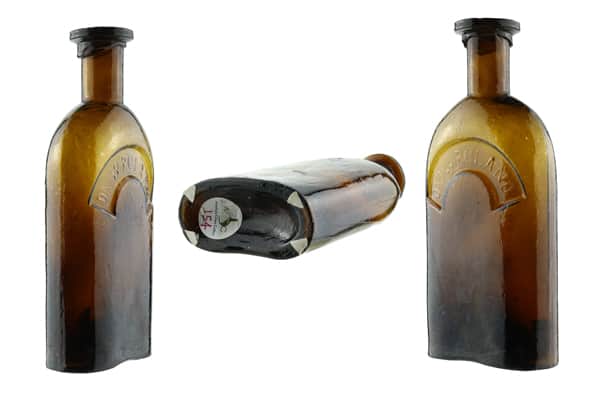
Rev. James W. Poland
Rev. James Willey Poland was born on April 24, 1808, in Stoneham, Massachusetts. He would marry Sarah Sweetser (1806-1893) on February 23, 1833, in Wakefield County, Middlesex, Massachusetts. We see no record of him actually having medical training but he certainly was a clergyman as he was ordained in 1834 and first served as a pastor in Manchester, New Hampshire from March 5, 1844, to January 1, 1847. He would also use “Dr.” in all of his medicinal product advertising though we never see a record of him having an office and seeing patients.
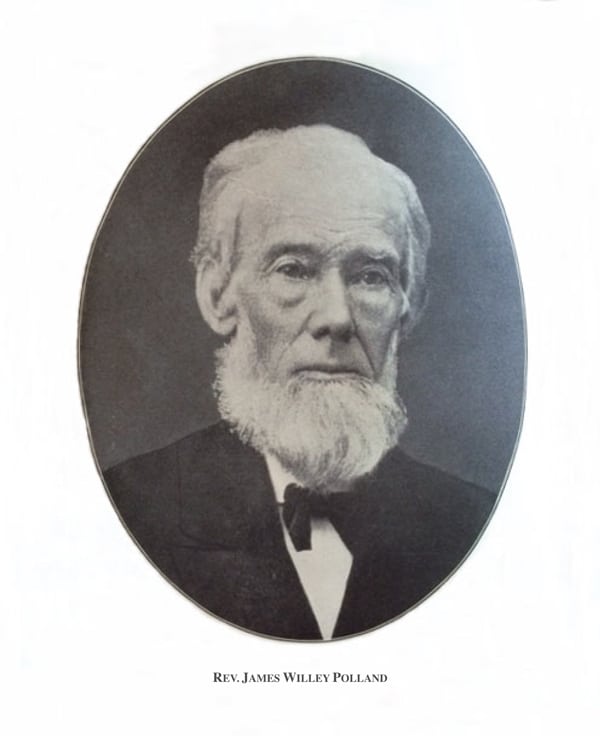
James W. Poland would settle in Manchester, New Hampshire in the 1840s as a spice dealer where he started manufacturing and selling medicines he originally concocted for treating himself and family members. The first formula was for the medicine he later called “Dr. J. W. Poland’s Humor Doctor” which was “A Positive Remedy for all kinds of Humors.” Most newspaper advertising, for example in 1867, said the medicine was first used in 1847 while other Dr. Poland advertising said first used in 1851. One advertisement testimonial said three bottles cured the ailment while another person said eleven bottles cured them.
Poland would follow with Dr. Poland’s White Pine Compound in 1855. Advertising said, “It was early in the spring of 1855 that this compound was originated. A member of my family was afflicted with an irritation of the throat, attended with a disagreeable cough. I had for some months previous thought that a preparation having for its basis the inside bark of white pine might be compounded as to be very useful in cases of the throat and lungs.” Poland went on to explain that his family member was cured within two days so he started sharing the compound with neighbors.
The medicine was a huge success and Dr. Poland found himself in a new profession as a proprietary medicine maker while still being a Baptist preacher as from March 28, 1850, to April 3, 1854, Rev. Poland would again serve as a pastor for one of the two Manchester Baptist churches. Next, Rev. J. W. Poland would move to Goffstown Centre which was a small town about 8-½ miles northwest of Manchester, N.H.
In 1854, there were newspaper advertisements in New England newspapers for “Dr. J. W. Poland’s Headache Killer!” which was an effectual remedy for the “Sick and Nervous Headache.” You were asked to “get a Circular from his Agents, and read concerning its origin, and what it has done for the afflicted. A faithful trial of the Medicine will assure you that it is no humbug.” All of his agents were listed and the copy said it was sold by Druggists and Medicine dealers generally. The advertisement closed with Dr. J. W. Poland & Co., Proprietors, Goffstown Centre, N. H. His two wholesale agents were Geo. C. Goodwin, 99 Union St., and Weeks & Potter, 154 Washington, St. in Boston, Mass. Dealers and Druggists were asked to purchase from them. The price was advertised at 50 cents per pint bottle.
In the 1860 United States Federal Census, James W. Poland was 52 years old and still living in Goffstown. His occupation was listed as a clergyman. His real estate value was $1,500 and his personal estate value was $800. There was a William C. Poland, age 14, and a Charles H. Poland, age 12, also listed as children.
By 1864 and 1865, Rev. Poland had moved to Melrose, Mass. and was actively making some of these medicines, especially the Poland’s Magic Powders along with Poland’s Indian Pile Remedy, Poland’s Pain Eraser, Poland’s White Mountain Bitters, Poland’s Cedar Plaster, Poland’s Diarrhea Elixir, Poland’s Canker and Chilblain Killer, and Poland’s Mandrake and Iron Pills, etc. Our subject museum bottle probably contained some of these products and used a paper label to identify the medicine.
In the 1860s, James W. Poland developed a relationship with Dr. George W. Swett of the New England Botanic Depot in Boston, Mass. By this time, Rev. Poland had moved back to Goffstown. Swett would heavily advertise the Dr. Poland products saying the medicines were made under the supervision of Rev. J. W. Poland, M.D. In 1864, Rev. Poland transferred the rights to just about all of his medicines to Swett. In the early 1870s, Littlefield & Hayes in Manchester, N.H. were the proprietors of Dr. J. W. Poland’s Family Medicines as they were now called.
Rev. James W. Poland served as the pastor for the Baptist Church of Goffstown for the last time from April 1, 1871, to January 1, 1875. The sale of the Dr. Poland brands continued after his retirement and advertisements for his many medicines continued into the early to mid-1870s. Rev. J. W. Poland would die on September 16, 1882, in Goffstown.
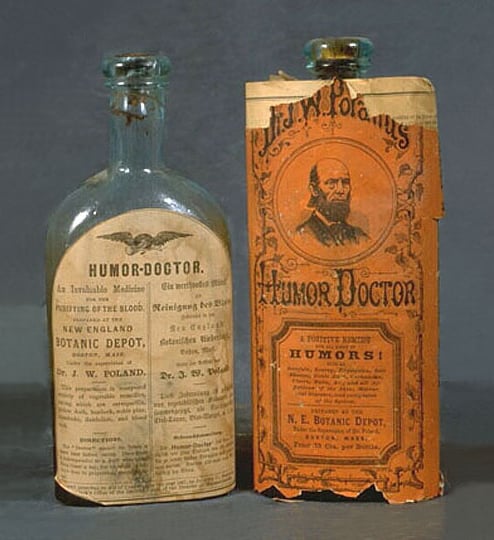
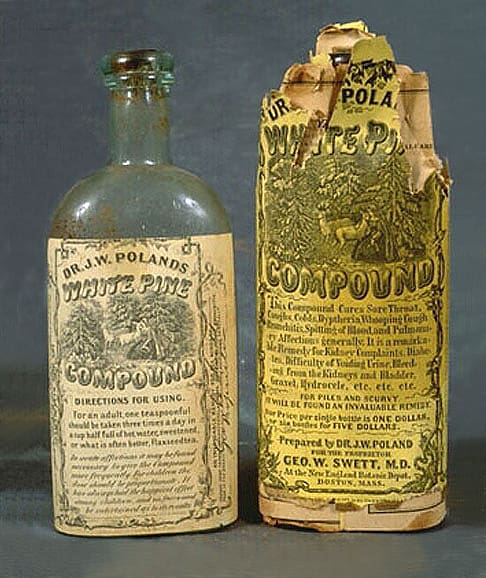
Primary Image: Dr. J. W. Poland bottle imaged on location by Alan DeMaison, FOHBC Virtual Museum Midwest Studio
Primary Image: Auction Lot 154: “Dr. J.W. Poland” Medicine Bottle, a Stoddard glasshouse, Stoddard, New Hampshire, 1855 – 1865. Bright olive amber shading to near yellow in the upper shoulder area, oval with an indented tombstone shaped front panel, crudely applied square collared mouth – smooth base, ht. 7 5/8”; (some exterior high point wear and a tiny, 1/16” flake on the edge of the square collar). An extremely rare Stoddard medicine with plenty of bubbles and character throughout. – John Pastor, American Glass Gallery, Auction #5
Support Image: Auction Lot 185: “Dr. J. W. Poland” Medicine Bottle, a Stoddard glasshouse, Stoddard, New Hampshire, 1860-1873. Oval with indented arched panel, medium olive amber, applied square collared mouth – smooth base, ht. 7 5/8 inches; (shallow 1/16 inch flake on edge of mouth, areas of wear above and below the embossing have been polished, exterior high point wear). AAM pg. 415 A rare and appealing Stoddard bottle. Generally fine condition. – Norman Heckler Jr. & Sr., Norman C. Heckler & Company, Auction #185
Support Image: Auction Lot 5: “Dr. J. W. Poland” Medicine Bottle, a Stoddard glasshouse, Stoddard, New Hampshire, 1860-1872. Oval with a semi-circular embossed indented panel, deep olive amber, applied square collared mouth – smooth base, ht. 7 7/8 inches; (front panel appears to be coated). See PME pg. 281 Extremely rare Stoddard medicine. Kris Kernozicky collection. – Norman Heckler Jr. & Sr., Norman C. Heckler & Company, Heckler Auction #102
Support Image: Auction Lot 197: “Dr. J.W. Poland’s / White Pine / Compound” Medicine Bottle, America, 1840-1860. Oval, aquamarine, tooled square collared mouth – pontil scar, ht. 7 inches; (1 3/8 inch bruise at pontil scar comes to edge of base). AAM pg. 415 Not often seen with this mouth application and a pontiled base. Generally fine condition. Dr. Charles and Jane Aprill collection. – Norman Heckler Jr. & Sr., Norman C. Heckler & Company, Auction #182
Support Image: Auction Lot 82: “J.W. Poland’s / Headache Killer” Medicine Bottle, probably Lyndeborough Glass Company, South Lyndeborough, New Hampshire, 1866-1886. Oval form, brilliant greenish aquamarine, applied square collared mouth – smooth base, ht. 7 1/4 inches. AAM pg. 415 A clean and bright example. – Norman Heckler Jr. & Sr., Norman C. Heckler & Company, Auction #122
Support Image: Auction Lot 8: “DR. J.W. POLAND”, New Hampshire, ca. 1855 – 1870, yellowish ‘old’ amber, 7 7/8”h, smooth base, applied mouth. An exceptional example, crude pebbly glass, and full of air bubbles! Hard to imagine a nicer one! – Jim Hagenbuch, Glass Works Auction, Auction #101
Support Image: Two glass bottles, one wrapped, one unwrapped, of Dr. J. W. Polands HUMOR DOCTOR, A POSITIVE REMEDY FOR ALL KINDS OF HUMORS! […] PREPARED AT THE N.E. BOTANIC DEPOT, Under the Supervision of Dr. Poland,/ BOSTON, MASS./ Price 75 Cts. per Bottle. Entered according to the act of Congress, 1867. Paper labels and wrappings. Height approximately 8-3/8 inches unwrapped. – The Throop Museum, Schoharie, N.Y.
Support Image: Two glass bottles, one wrapped, one unwrapped, of DR. J. W. POLANDS WHITE PINE COMPOUND. Prepared by DR. J. W. POLAND FOR THE PROPRIETOR GEO. W. SWETT, M.D. At the New England Botanic Depot. BOSTON, MASS. Entered according to the act of Congress, 1865. Paper labels and wrappings. Height approximately 7-¼ inches unwrapped. – The Throop Museum, Schoharie, N.Y.
Support: Reference to: Dr. J. W. Poland – Great New England Medicines, Ferdinand Meyer V, PeachridgeGlass.com, February 7, 2013
Support: Reference to: Dr. JW Poland: The Headache Killer! by Michael George
Join the FOHBC: The Virtual Museum is a project of the Federation of Historical Bottle Collectors (FOHBC). To become a member.

